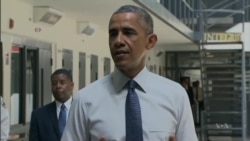U.S. President Barack Obama became the first sitting president to visit a federal prison as part of his push for fairer justice system and prison reform.
Obama traveled Thursday to El Reno prison in the midwestern state of Oklahoma, where he was to meet separately with law enforcement officials and nonviolent drug offenders.
In a speech earlier this week, Obama called for either reducing or eliminating mandatory minimum sentences for non-violent drug crimes, reconsidering solitary confinement for prisoners and increasing job training programs for people while they are incarcerated.
He also announced a federal review of the use of solitary confinement and urged Congress to pass a sentencing reform bill by year's end.
The president has said that overly harsh sentences are responsible for the doubling of the U.S. prison population in the last 20 years.
Obama acknowledged that many people in the U.S. need to be in prison — "murderers, predators, rapists, gang leaders'' — yet, he said that in too many instances, law enforcement is treating young black and Latino men differently than their white peers.
The United States is the world's largest jailer accounting for nearly 25 percent of the world's prison population despite making up just less than five percent of the world's population.
10 Facts About the US Prison System
- The United States’ current prison population totals 2.3 million people. Roughly one in 100 adults lives behind bars. (ACLU.org)
- African-Americans are incarcerated at nearly six times the rate of whites and constitute nearly 1 million of the prison population of 2.3 million. (NAACP.org)
- The lifetime likelihood of imprisonment is 1 in 3 for Black men; 1 in 6 for Latino men; and 1 in 17 for White men. (SentencingProject.org)
- African Americans represent 12% of the total population of drug users, but make up 38% of those arrested for drug offenses. More than half of those arrested (59%) receive prison sentences as opposed to probation or drug rehabilitation. (NAACP.org)
- One in 9 prisoners is serving a life sentence. In 2012, close to 160,000 people were serving life sentences, with nearly 50,000 serving life sentences without parole. (SentencingProject.org)
- The annual cost to house an inmate in a Federal prison is just over $29,000. For state prisons, the price per inmate averages around $31,000. (Federal Bureau of Prisons, Vera.org)
- In 48 states, a felony conviction can result in the loss of voting rights, thereby affecting the political voice of many communities. Nearly 6 million Americans are unable to vote due to felony disenfranchisement policies. (SentencingProject.org)
- The number of youths in prison has declined steadily from a peak of nearly 78,000 in 1999 to just over 35,000 in 2013. (SentencingProject.org)
- Black, Latino, and American Indian youths enter the prison system more frequently and are more likely to be sentenced to harsher punishments. (SentencingProject.org)
- The southern states of Louisiana and Mississippi have the highest incarceration rates. Maine and Minnesota have the country's lowest. (SentencingProject.org)









